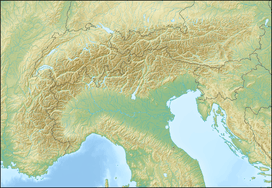Stelvio Pass
| Stelvio Pass | |
|---|---|
|
Passo dello Stelvio (Italian) Stilfser Joch (German) | |
 Some of the 48 hairpin turns near the top of the eastern ramp of the Stelvio Pass | |
| Elevation | 2757 m |
| Traversed by | Strada Statale 38 |
| Location |
On the border of South Tyrol and Province of Sondrio, |
| Range | Eastern Alps |
| Coordinates | 46°31′43″N 10°27′10″E / 46.52861°N 10.45278°ECoordinates: 46°31′43″N 10°27′10″E / 46.52861°N 10.45278°E |
 Stelvio Pass | |
The Stelvio Pass (Italian: Passo dello Stelvio; German: Stilfser Joch), located in Italy, at 2757 m (9045 feet) is the highest paved mountain pass in the Eastern Alps, and the second highest in the Alps, slightly below the Col de l'Iseran (2770 m, 9088 feet).
Location
The pass is located in the Ortler Alps in Italy between Stilfs ("Stelvio" in Italian) in South Tyrol and Bormio in the province of Sondrio. It is some 75 km (47 mi) from Bolzano and just 200 m from the Swiss border. The Umbrail Pass runs northwards from the Stelvio's western ramp. The "Three languages peak" (Dreisprachenspitze) above the pass is so named because this is where the Italian, German and Romansh languages meet.
The road connects the Valtellina with the mid Venosta valley (the Vinschgau) and Meran. Adjacent to the pass road there is a large summer skiing area. Important mountains nearby include Ortler, Thurwieserspitze, Trafoier Eiswand, de:Monte Scorluzzo, Piz Umbrail, and Piz Cotschen/Rötlspitz/Punta Rosa. [1]
History
The original road was built in 1820-25 by the Austrian Empire to connect the former Austrian province of Lombardia with the rest of Austria, covering a climb of 1871 m. The engineer and project manager was Carlo Donegani (1775–1845). Since then, the route has changed very little. Its seventy five [citation needed] hairpin turns, 48 of them on the northern side numbered with stones, are a challenge to motorists. Stirling Moss went off the road here during a vintage car event in the 1990s, with an onboard video of his incident being shown on satellite TV.
Before the end of World War I, it formed the border between the Austro-Hungarian Empire and the Italian Kingdom. The Swiss had an outpost and a hotel (which was destroyed) on the Dreisprachenspitze (literally, Three-Language-Peak). During World War I, fierce battles were fought in the ice and snow of the area, with gun fire even crossing the Swiss area at times. The three nations made an agreement not to fire over Swiss territory, which jutted out in between Austria (to the north) and Italy (to the south). Instead they could fire down the pass, as Swiss territory was up and around the peak.[2][3] After 1919, with the expansion of Italy, the pass lost its strategic importance.
The Stelvio Pass retains an importance for sport when it is open from June to September. Countless cyclists and motorcyclists struggle to get to the highest stretch of road in the Eastern Alps. It is the highest finish of any Grand Tour.[4] The Giro d'Italia often crosses the Stelvio Pass (it was crossed by the Giro for the first time in 1953, when Coppi beat Koblet). The last winner on the pass was Thomas De Gendt in 2012. Every year, the pass is closed to motor vehicles on one day in late August when about 8000 cyclists ride on the Stelvio.
Bormio regularly hosts World Cup ski racing; its Pista Stelvio is among the most challenging men's downhill courses on the circuit.
The Stelvio Pass was also picked by the British automotive show Top Gear as its choice for the "greatest driving road in the world", although their search was concentrated only in Europe.[5][6] This conclusion was reached after the team went in search of a road that would satisfy every "petrolhead's" driving fantasies in the premiere of the show's 10th season. Top Gear later decided that the Transfăgărăşan Highway in Romania was possibly a superior driving road. In 2008, Moto Guzzi started selling a Stelvio model, named after the famous mountain pass.
See also
- List of highest paved roads in Europe
- List of mountain passes
- Trollstigen
- Transfăgărășan
Notes
- ↑ "Monte Scorluzzo : Climbing, Hiking & Mountaineering". SummitPost. Retrieved 2010-12-02.
- ↑ "WWI Isonzo Front, the Soča Valley, Slovenia". Slovenia-Walking. Retrieved 2010-12-02.
- ↑ "The Stelvio pass". Bormio3.com. Retrieved 2010-12-02.
- ↑ Stelvio climb – the highest of any Grand Tour.
- ↑ "Top Gear’s World’s Best Driving Road in detail at redlineblog – Indian Car Reviews". Redlineblog.com. 2007-11-01. Retrieved 2010-12-02.
- ↑ "3. Stelvio Pass / South Tyrol / Italy Mountain Pass Driving Route and Map in TOP 10 DRIVES Region : Driving Breaks". Ultimatedrives.net. Retrieved 2010-12-02.
References
- Harrison, Greg, "Over the Top; Motorcycle touring in the Alps", American Motorcyclist: 41+, retrieved 2011-01-03
- Coleman, Colette (2008), Planet Earth's Greatest Motorcycle Adventure Tours, MBI Publishing Company, pp. 174+, ISBN 0-7603-3545-1
External links
| Wikimedia Commons has media related to Passo dello Stelvio. |
- Profile on climbbybike.com
- Photos Hairpins, Map, and Cycling Elevation Profile
- Michelin map of 23032 Passo dello Stelvio
- Photo of Stilfser Joch north ramp and Monte Scorluzzo
- Pictures from Stelvio Pass - August 2010 (text in Romanian)